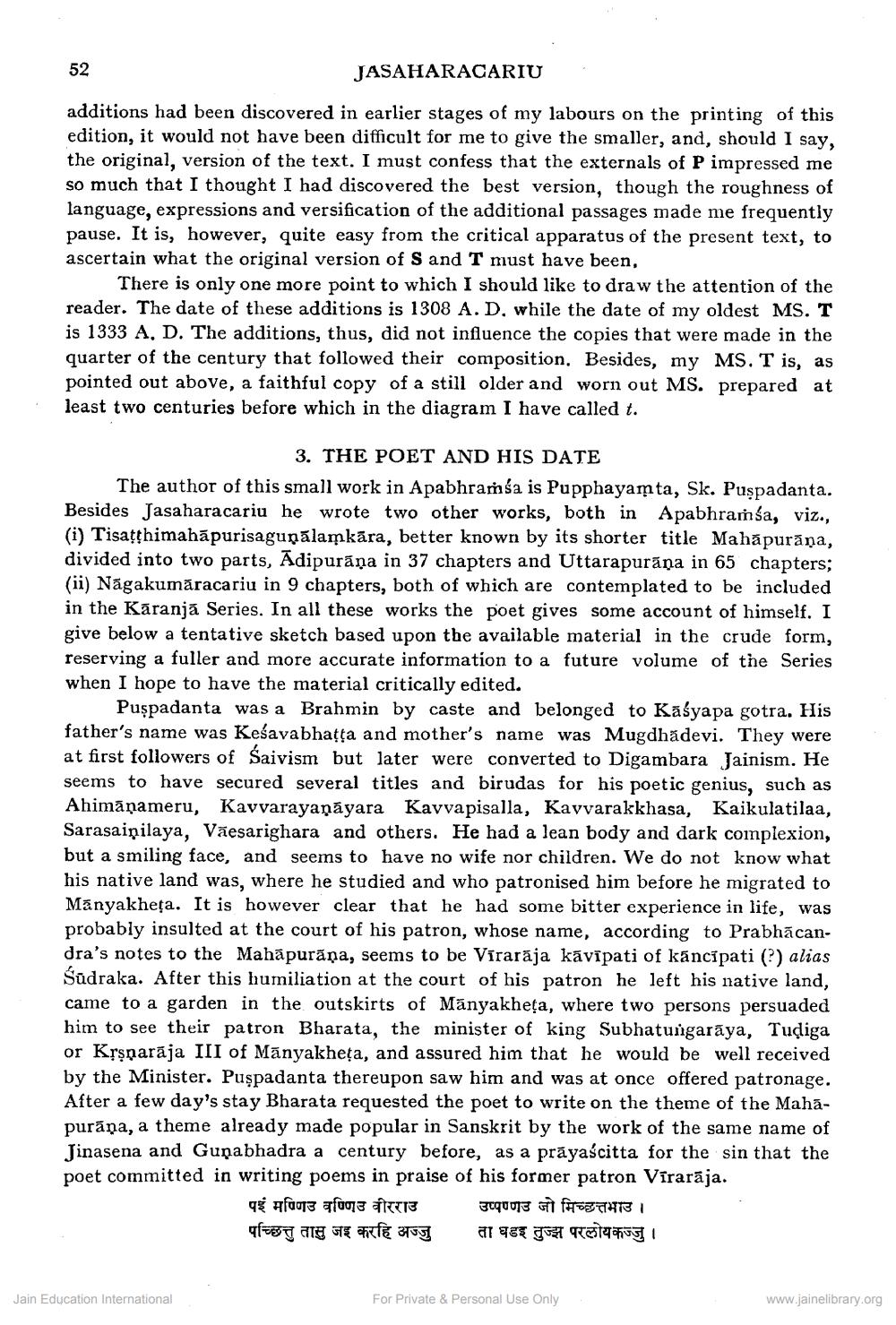________________
52
JASAHARACARIU
additions had been discovered in earlier stages of my labours on the printing of this edition, it would not have been difficult for me to give the smaller, and, should I say, the original, version of the text. I must confess that the externals of P impressed me so much that I thought I had discovered the best version, though the roughness of language, expressions and versification of the additional passages made me frequently pause. It is, however, quite easy from the critical apparatus of the present text, to ascertain what the original version of S and T must have been,
There is only one more point to which I should like to draw the attention of the reader. The date of these additions is 1308 A. D, while the date of my oldest MS. T is 1333 A. D. The additions, thus, did not influence the copies that were made in the quarter of the century that followed their composition. Besides, my MS. T is, as pointed out above, a faithful copy of a still older and worn out MS. prepared at least two centuries before which in the diagram I have called t.
3. THE POET AND HIS DATE The author of this small work in Apabhramsa is Pupphayasta, Sk. Puşpadanta. Besides Jasaharacariu he wrote two other works, both in Apabhramsa, viz., (i) Tisatthimahāpurisaguņālamkāra, better known by its shorter title Mahăpurāņa, divided into two parts, Adipurāņa in 37 chapters and Uttarapurāņa in 65 chapters; (ii) Nāgakumăracariu in 9 chapters, both of which are contemplated to be included in the Kāranjā Series. In all these works the poet gives some account of himself. I give below a tentative sketch based upon the available material in the crude form, reserving a fuller and more accurate information to a future volume of the Series when I hope to have the material critically edited.
Puşpadanta was a Brahmin by caste and belonged to Kāśyapa gotra. His father's name was Keśavabhatta and mother's name was Mugdhadevi. They were at first followers of Saivism but later were converted to Digambara Jainism. He seems to have secured several titles and birudas for his poetic genius, such as Ahimāņameru, Kavyarayaņāyara Kavvapisalla, Kavvarakkhasa, Kaikulatilaa, Sarasaiņilaya, Vãesarighara and others. He had a lean body and dark complexion, but a smiling face, and seems to have no wife nor children. We do not know what his native land was, where he studied and who patronised him before he migrated to Manyakheța. It is however clear that he had some bitter experience in life, was probably insulted at the court of his patron, whose name, according to Prabhācandra's notes to the Mahāpurāņa, seems to be Vírarāja kāvīpati of káncípati () alias Śūdraka. After this humiliation at the court of his patron he left his native land, came to a garden in the outskirts of Mānyakheța, where two persons persuaded him to see their patron Bharata, the minister of king Subhatungarāya, Tudiga or Krşnarāja III of Mānyakheța, and assured him that he would be well received by the Minister. Puşpadanta thereupon saw him and was at once offered patronage. After a few day's stay Bharata requested the poet to write on the theme of the Mahapurāna, a theme already made popular in Sanskrit by the work of the same name of Jinasena and Guṇabhadra a century before, as a prayascitta for the sin that the poet committed in writing poems in praise of his former patron Virarāja.
पई मण्णिउ वण्णिउ वीरराउ उप्पण्णउ जो मिच्छत्तभाउ । पच्छित्तु तासु जइ करहि अज्जु ता घडइ तुज्झ परलोयकज्जु ।
Jain Education International
For Private & Personal Use Only
www.jainelibrary.org




